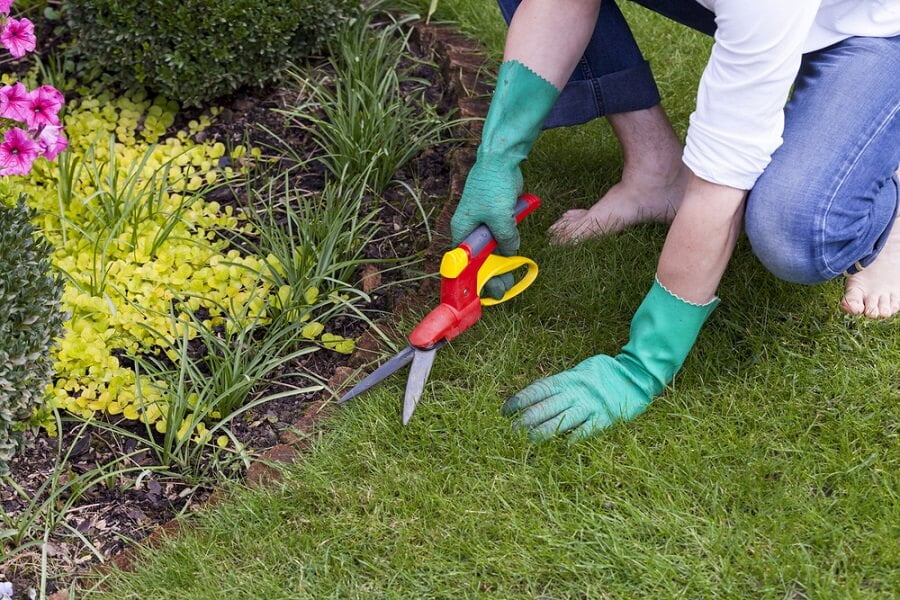Are you unsure about how often to water your evergreen trees? Proper watering is crucial for the health and longevity of these beautiful trees. In this article, we will guide you through the process of understanding the watering needs of evergreen trees and provide you with expert tips to ensure their safety.
When it comes to watering your evergreen trees, it’s important to consider the climate and environmental factors that can affect their water requirements. By watering deeply and infrequently, you can promote healthy root growth and prevent shallow root systems. Monitoring soil moisture levels using a moisture meter will help you determine when to water. Additionally, adjusting your watering frequency based on seasonal changes is essential to meet the changing needs of your trees.
To avoid underwatering or overwatering, it is crucial to pay attention to signs such as wilting, yellowing leaves, or excessive shedding. Mulching around the base of the tree will help retain moisture and protect the roots. However, for personalized advice, it’s always a good idea to consult with a professional arborist.
By following these guidelines, you can ensure the safety and well-being of your evergreen trees and enjoy their beauty for years to come.
Quick Summary
- Water deeply and infrequently to promote healthy root growth
- Use a moisture meter to monitor soil moisture levels
- Adjust watering frequency based on seasonal changes, climate, and environmental factors
- Spread mulch around the base of trees to retain moisture, regulate soil temperature, and suppress weed growth
Understand the Watering Needs of Evergreen Trees
Evergreen trees, like steadfast sentinels, require regular watering to quench their insatiable thirst and keep their vibrant foliage alive and thriving. Understanding watering techniques and establishing a proper watering schedule is crucial to ensure the health and longevity of these majestic trees.
To properly water evergreen trees, you must first consider the soil conditions. Well-draining soil is essential, as it allows water to penetrate deep into the roots while preventing excess moisture that can lead to root rot. If your soil lacks proper drainage, consider amending it with organic matter to improve its structure.
When it comes to watering frequency, it is important to strike a balance. Too much water can suffocate the roots and promote fungal diseases, while too little water can cause the tree to dry out and suffer. As a general rule, water evergreen trees deeply but infrequently. This means giving them a thorough soak once every 10 to 14 days, allowing the water to penetrate at least 6 inches into the soil.
In hot and dry climates, you may need to increase the frequency of watering during the summer months. Pay attention to signs of stress such as wilting or yellowing foliage, as these indicate that the tree is not receiving enough water.
By understanding the watering needs of evergreen trees and establishing a proper watering schedule, you can ensure their vitality and beauty for years to come. Remember, a well-hydrated evergreen tree is a happy and healthy tree.
Consider the Climate and Environmental Factors
Incorporating the climate and environmental factors into your watering routine will ensure that these sturdy giants thrive. When it comes to watering evergreen trees, it’s important to consider a few key factors that can help you choose the right watering schedule. By understanding the specific needs of these trees and taking into account the climate and environmental conditions, you can provide them with the optimal amount of water they require.
Factors to consider when watering evergreen trees include the type of soil, the tree’s age and size, and the amount of rainfall in your area. Different soil types hold water differently, so it’s crucial to understand the drainage capacity of your soil. Sandy soils drain water quickly, while clay soils retain water for longer periods. The age and size of the tree also play a role in determining its water needs. Younger trees require more frequent watering, while mature trees have established root systems that can access deep water sources.
To help you determine the right watering schedule for your evergreen trees, here’s a table that outlines the general guidelines:
| Environmental Factors | Watering Frequency |
|---|---|
| Hot and Dry Climate | Every 7-10 days |
| Mild and Humid Climate | Every 10-14 days |
| Rainy Climate | Adjust watering based on rainfall |
By considering these factors and using the table as a guide, you can ensure that your evergreen trees receive the proper amount of water they need to thrive. Remember to always monitor the soil moisture and adjust your watering routine accordingly. With a well-managed watering schedule, your evergreen trees will stay healthy and vibrant for years to come.
Water Deeply and Infrequently
To maximize growth and health, it’s recommended to deeply water your evergreen trees at longer intervals. Deep watering is crucial for tree health because it encourages the development of a strong and extensive root system.
By watering deeply, you ensure that the water penetrates the soil and reaches the roots, providing them with the necessary moisture they need to thrive. When you water your evergreen trees deeply, you allow the roots to grow deeper into the ground, making them more resilient to drought conditions. This deep root system also helps the trees withstand strong winds and storms, reducing the risk of them toppling over. By giving your trees a deep soak, you promote their overall stability and safety.
In addition to deep watering, it’s important to water your evergreen trees infrequently. This allows the soil to dry out in between waterings, which encourages the roots to seek out moisture deeper in the ground. By watering less frequently, you also reduce the risk of overwatering, which can lead to root rot and other diseases.
Deep watering your evergreen trees at longer intervals is essential for their health and well-being. By following this watering practice, you promote the development of a strong root system, enhance their stability, and reduce the risk of overwatering.
Keep your evergreen trees healthy and safe by providing them with deep, infrequent watering.
Use a Moisture Meter to Monitor Soil Moisture Levels
Using a moisture meter is a simple and effective way to keep track of the moisture levels in your soil, ensuring that your evergreen trees receive the right amount of water for optimal growth and health. Here are the benefits of using a moisture meter for your evergreen trees:
-
Accurate Monitoring: A moisture meter provides you with accurate and real-time information about the moisture levels in your soil. This allows you to water your evergreen trees only when necessary, avoiding overwatering or underwatering.
-
Prevents Underwatering: Underwatering can cause stress to your evergreen trees and lead to stunted growth or even death. By using a moisture meter, you can easily detect when the soil is too dry and take immediate action to provide enough water.
-
Avoids Overwatering: Overwatering can be just as harmful as underwatering. It can lead to root rot and other diseases that can damage your evergreen trees. With a moisture meter, you can ensure that you’re not overwatering your trees, promoting their overall health and longevity.
When choosing a moisture meter for your evergreen trees, consider the following factors:
-
Type of Meter: There are different types of moisture meters available, such as probe meters or capacitance meters. Choose one that suits your needs and preferences.
-
Accuracy: Look for a moisture meter that provides accurate readings to ensure reliable monitoring of soil moisture levels.
-
Ease of Use: Choose a moisture meter that’s easy to use and understand, with clear instructions for accurate readings.
By using a moisture meter, you can effectively monitor and maintain the right moisture levels for your evergreen trees, promoting their growth and ensuring their well-being.
Adjust Watering Frequency Based on Seasonal Changes
Don’t let your evergreen trees suffer from inadequate hydration. Adjust watering frequency based on seasonal changes for their optimal growth and well-being. Properly maintaining the moisture levels in the soil is crucial for the health of your evergreen trees.
One effective way to do this is by adjusting the watering schedule according to the seasons.
During the spring and fall, when temperatures are moderate and rainfall is more frequent, you may need to water your evergreen trees less often. This is because the soil tends to retain more moisture naturally during these seasons. However, be cautious not to overwater, as excessive moisture can lead to root rot and other fungal diseases.
In the hot summer months, when evaporation rates are higher and rainfall is scarce, you will likely need to increase the frequency of watering. The hot sun can quickly dry out the soil, leaving your evergreen trees thirsty and susceptible to stress and damage. Monitor the moisture levels closely and adjust your watering schedule accordingly.
During the cold winter months, evergreen trees go dormant and require less water. Reduce the frequency of watering to prevent waterlogged soil, which can cause root damage and inhibit growth.
By adjusting your watering schedule based on seasonal changes, you can ensure that your evergreen trees receive the right amount of water at the right time. This will promote their optimal growth and well-being, keeping them healthy and vibrant throughout the year.
Is the Watering Frequency the Same for Indian Hawthorn and Evergreen Trees?
When it comes to watering indian hawthorn and evergreen trees, the frequency may differ. Indian Hawthorn plants require frequent watering, especially during their first growing season, to establish deep roots. On the other hand, evergreen trees have varying watering needs depending on the specific species. It is essential to research and understand the watering requirements of each plant to ensure their healthy growth.
Pay Attention to Signs of Underwatering or Overwatering
Be mindful of the telltale signs that your evergreen trees may be experiencing either insufficient or excessive hydration. These signs can provide valuable insight into the health of your trees and help you adjust your watering routine accordingly.
Here are four key signs to watch out for:
-
Wilting foliage: If you notice the needles or leaves of your evergreen trees drooping or losing their vibrant color, it could be a sign of dehydration. Lack of water can cause the foliage to become dry and brittle.
-
Yellowing or browning needles: Another sign of dehydration is when the needles start turning yellow or brown. This indicates that the tree is not receiving enough water to sustain proper growth and health.
-
Root rot: On the other hand, overwatering can lead to root rot, which is characterized by a foul odor, dark and mushy roots, and a decline in the overall health of the tree. Excessive moisture can suffocate the roots and promote the growth of harmful fungi.
-
Pests and diseases: Both underwatering and overwatering can make evergreen trees more susceptible to pests and diseases. When the tree is stressed from lack of water or drowning in excess moisture, it becomes weaker and more vulnerable to attacks from insects and pathogens.
By paying attention to these signs, you can ensure that your evergreen trees receive the right amount of water for optimal health and safety. Regularly monitoring and adjusting your watering routine will help keep your trees thriving and resistant to potential threats.
Mulch Around the Base of the Tree to Retain Moisture
Spread a layer of mulch around the base of your evergreen trees to create a protective barrier that locks in moisture and nourishes the roots, like a cozy blanket for your tree’s thirsty roots. Using organic mulch is highly recommended as it provides numerous benefits to your trees.
The mulch acts as a natural insulator, helping to regulate the soil temperature and protect the roots from extreme weather conditions. This is especially important during hot summer days or cold winter nights when the soil can quickly lose its moisture content.
In addition to temperature regulation, mulching also helps to retain moisture in the soil. It acts as a barrier, preventing water from evaporating too quickly and allowing the roots to absorb the moisture they need. This is particularly beneficial in areas with dry or arid climates where water conservation is essential.
Furthermore, mulch helps to suppress weed growth around your evergreen trees. Weeds compete with your trees for nutrients and water, potentially causing stress and hindering their growth. By applying a layer of mulch, you can smother weed seeds and prevent them from germinating, reducing the competition and allowing your trees to thrive.
Overall, using organic mulch around the base of your evergreen trees offers a range of benefits, including moisture retention, temperature regulation, and weed suppression. By providing your trees with this cozy blanket of mulch, you are ensuring their well-being and promoting their healthy growth. So go ahead and give your trees the TLC they deserve by mulching around their base.
Consult with a Professional Arborist for Expert Advice
Consider reaching out to a professional arborist who can provide expert advice tailored to your specific needs and concerns.
When it comes to watering evergreen trees, it’s important to understand that each tree has unique requirements. Expert recommendations from a professional arborist can help ensure that you’re providing the right amount of water to your evergreen trees.
Why is professional advice important? Well, watering trees incorrectly can lead to serious consequences such as root rot, disease, or even death of the tree. A professional arborist can assess the specific needs of your evergreen trees based on factors like soil type, climate, and tree species. They can provide guidance on how often to water your trees and how much water to give them.
Remember, overwatering can be just as harmful as underwatering. Too much water can suffocate the roots and promote fungal growth, while too little water can cause stress and dehydration.
By consulting with a professional arborist, you can ensure that you’re maintaining the optimal moisture levels for your evergreen trees. This expert advice will help keep your trees healthy and thriving for years to come.
So, don’t hesitate to seek professional guidance when it comes to watering your evergreen trees.
Frequently Asked Questions
Can I water evergreen trees too much?
Yes, you can water evergreen trees too much. Overwatering risks include root rot and fungal diseases. Signs of overhydration include yellowing leaves, wilting, and stunted growth. It’s important to water them properly to ensure their health.
How do I know if my evergreen tree is being underwatered?
To ensure the health of your evergreen tree, it’s crucial to recognize signs of underwatering. Look out for wilting, yellowing or browning leaves, and dry soil. Proper watering is vital for your tree’s well-being.
Is it necessary to use a moisture meter to monitor soil moisture levels?
Using a moisture meter is more accurate than visual inspection in determining soil moisture levels. It ensures the right amount of water for your evergreen trees, promoting their health and preventing over or under watering risks.
What are the signs of overwatering in evergreen trees?
To prevent overwatering in evergreen trees, look for signs such as yellowing leaves, wilting, or root rot. Adjust your watering schedule accordingly and ensure proper drainage. Avoid overwatering by allowing the top inch of soil to dry out between waterings.
How can mulching around the base of the tree help retain moisture?
Mulching benefits evergreen trees by retaining moisture around the base, helping to conserve water. It creates a protective barrier, prevents evaporation, and reduces weed growth, ensuring the tree receives adequate hydration while promoting a safe and healthy environment.
Conclusion
In conclusion, taking proper care of evergreen trees requires understanding their watering needs and considering environmental factors. By watering deeply and infrequently, using a moisture meter, and adjusting watering frequency based on seasonal changes, you can ensure the health and vitality of your trees.
It’s important to pay attention to signs of both underwatering and overwatering and to mulch around the base of the tree to retain moisture.
If you’re unsure about any aspect of tree care, consulting with a professional arborist is always a wise choice.









